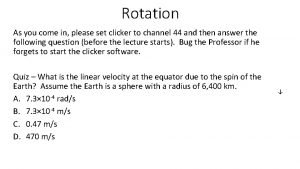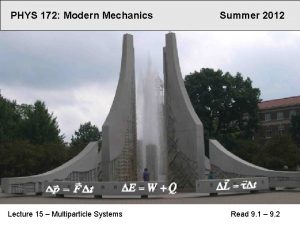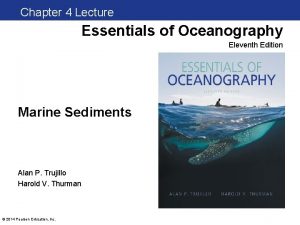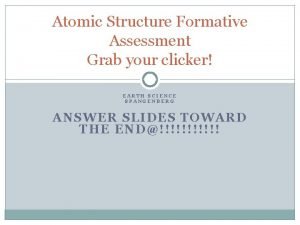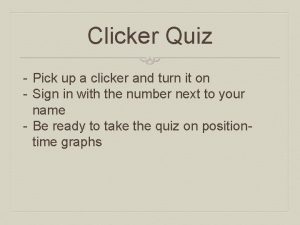Using the Clicker If you have a clicker





























- Slides: 29

Using the “Clicker” If you have a clicker now, and did not do this last time, please enter your ID in your clicker. First, turn on your clicker by sliding the power switch, on the left, up. Next, store your student number in the clicker. You only have to do this once. Press the * button to enter the setup menu. Press the up arrow button to get to ID Press the big green arrow key Press the T button, then the up arrow to get a U Enter the rest of your BU ID. Press the big green arrow key.

Archimedes’ Principle This is true - the buoyant force acting on an object is proportional to the volume of fluid displaced by that object. But, we can say more than that. The buoyant force acting on an object is equal to the weight of fluid displaced by that object. This is Archimedes’ Principle.

Three Blocks We have three cubes of identical volume but different density. We also have a container of fluid. The density of Cube A is less than the density of the fluid; the density of Cube B is exactly equal to the density of the fluid; and the density of Cube C is greater than the density of the fluid. When these objects are all completely submerged in the fluid, as shown, which cube displaces the largest volume of fluid? 1. Cube A 2. Cube B 3. Cube C 4. The cubes all displace equal volumes of fluid

Three Blocks Each cube displaces a volume of fluid equal to its own volume, and the cube volumes are equal so the volumes of fluid displaced are all equal.

Three Blocks Which object has the largest buoyant force acting on it? 1. Cube A 2. Cube B 3. Cube C 4. The cubes have equal buoyant forces

Three Blocks Each cube displaces an equal volume of the same fluid, so the buoyant force is the same on each.

Weight in a Boat A boat containing a heavy anchor floats in a reservoir. If the anchor is thrown overboard and is completely submerged, what happens to the water level in the reservoir? 1. The water level falls 2. The water level rises 3. The water level stays the same

Weight in a Boat When the anchor is in the water, it displaces a volume of water that ___________. When the anchor is in the boat, it is responsible for displacing a volume of water that ___________. Which of these is larger?

Weight in a Boat When the anchor is in the water, it displaces a volume of water that is equal to the volume of the anchor. When the anchor is in the boat, it is responsible for displacing a volume of water that ___________. Which of these is larger?

Weight in a Boat When the anchor is in the water, it displaces a volume of water that is equal to the volume of the anchor. When the anchor is in the boat, it is responsible for displacing a volume of water that has a weight equal to the weight of the anchor. Which of these is larger?

Weight in a Boat When the anchor is in the water, it displaces a volume of water that is equal to the volume of the anchor. When the anchor is in the boat, it is responsible for displacing a volume of water that has a weight equal to the weight of the anchor. Which of these is larger? The second one. The anchor, because it is more dense than water, displaces more water when it is in the boat. Thus, the water level drops when the anchor is thrown overboard, displacing less water.

Density (Mass density, that is) Mass density is mass per unit volume: If an object has a lower density than a surrounding fluid, the object floats in the fluid; if the object has a higher density it sinks. A material’s specific gravity is the ratio of the density of the material to the density of water at 4°C. What is special about water at 4°C? Aluminum has a specific gravity of 2. 7 – it is 2. 7 times more denser than water at 4°C.

Density (Mass density, that is) Mass density is mass per unit volume: If an object has a lower density than a surrounding fluid, the object floats in the fluid; if the object has a higher density it sinks. A material’s specific gravity is the ratio of the density of the material to the density of water at 4°C. What is special about water at 4°C? Water is most dense at that temperature. Aluminum has a specific gravity of 2. 7 – it is 2. 7 times more denser than water at 4°C.

A table of densities Material Density (kg/m 3) Interstellar space 10 -20 Air (20°C, 1 atm. ) 1. 21 Water (4°C, 1 atm. ) 1000 Sun (average) 1400 Earth (the planet) 5500 Iron 8700 Mercury (the metal) 13600 Black hole 1019

Pressure is force per unit area: The force exerted on an object by a fluid is toward the object and perpendicular to its surface. At a microscopic level, the force is associated with the atoms and molecules in the fluid bouncing elastically from the object. The SI unit for pressure is the pascal. 1 Pa = 1 N/m 2

Atmospheric pressure 1 atm = 1. 01 x 105 Pa = 14. 7 psi = 760 torr (psi = pounds / square inch) At atmospheric pressure, every square meter has a force of 100, 000 N exerted on it, coming from air molecules bouncing off it! Why don’t we, and other things, collapse because of this pressure?

Atmospheric pressure 1 atm = 1. 01 x 105 Pa = 14. 7 psi = 760 torr (psi = pounds / square inch) At atmospheric pressure, every square meter has a force of 100, 000 N exerted on it, coming from air molecules bouncing off it! Why don’t we, and other things, collapse because of this pressure? We have an internal pressure of 1 atmosphere. Objects like tables do not collapse because forces on top surfaces are balanced by forces on bottom surfaces, etc.

Unbalancing the forces If we remove the balance between forces, we can produce some interesting effects. Demonstrations of this include: 1. The Magdeburg hemispheres (see below) 2. Crushing a can 3. The atmosphere cannon

Crush a can Remember that this is just the collective effect of a bunch of air molecules!

Atmosphere cannon Estimate the speed of the ping-pong ball. Step 1: Step 2:

Rank by pressure A container, closed on the right side but open to the atmosphere on the left, is almost completely filled with water, as shown. Three points are marked in the container. Rank these according to the pressure at the points, from highest pressure to lowest. 1. 2. 3. 4. 5. 6. A=B>C B>A=C C>B>A C>A=B some other order

Pressure in a static fluid A static fluid is a fluid at rest. In a static fluid: • Pressure increases with depth. • Two points at the same vertical position experience the same pressure, no matter what the shape of the container. If point 2 is a vertical distance h below point 1, and the pressure at point 1 is P 1, the pressure at point 2 is: Point 2 does not have to be directly below point 1 - what matters is the vertical distance. Simulation

Measuring pressure The relationship between pressure and depth is exploited in manometers (or barometers) that measure pressure. A standard barometer is a tube with one end sealed. The sealed end is close to zero pressure, while the other end is open to the atmosphere. The pressure difference between the two ends of the tube can maintain a column of fluid in the tube, with the height of the column being proportional to the pressure difference.

Water pressure At the surface of a body of water, the pressure you experience is atmospheric pressure. Estimate how deep you have to dive to experience a pressure of 2 atmospheres.

Water pressure At the surface of a body of water, the pressure you experience is atmospheric pressure. Estimate how deep you have to dive to experience a pressure of 2 atmospheres. h works out to 10 m. Every 10 m down in water increases the pressure by 1 atmosphere.

The origin of the buoyant force The net upward buoyant force is the vector sum of the various forces from the fluid pressure. Because the fluid pressure increases with depth, the upward force on the bottom surface is larger than the downward force on the upper surface of the immersed object. This is for a fully immersed object. For a floating object, h is the height below the water level, so we get:

When the object goes deeper If we displace the object deeper into the fluid, what happens to the buoyant force acting on it? Assume the fluid density is the same at all depths. The buoyant force: 1. increases 2. decreases 3. stays the same

When the object goes deeper If the fluid density does not change with depth, all the forces increase by the same amount, leaving the buoyant force unchanged!

Whiteboard
 You are not rejected
You are not rejected 6 oblong faces
6 oblong faces Math clicker
Math clicker E clicker
E clicker Turning point audience response system
Turning point audience response system Lesson 5 building an app clicker game
Lesson 5 building an app clicker game Earth clicker
Earth clicker Heart rate clicker
Heart rate clicker Japan movie rape
Japan movie rape Clicker stop motion
Clicker stop motion Cooi clicker
Cooi clicker Umbc clicker
Umbc clicker Clicker box
Clicker box Youtube youtube
Youtube youtube Clicker stop motion
Clicker stop motion Clicker
Clicker Particl clicker
Particl clicker Hlyniany
Hlyniany Salt clicker
Salt clicker Clicker gravel transport
Clicker gravel transport Atomic clicker
Atomic clicker Spacebar clicker
Spacebar clicker Dynamic problem
Dynamic problem Question ball questions
Question ball questions Presentation clicker challenger
Presentation clicker challenger Cosine rule bbc
Cosine rule bbc Atomic clicker
Atomic clicker Clicker fungus
Clicker fungus Clicker questions physics
Clicker questions physics I studied hard because i knew that the test would
I studied hard because i knew that the test would











